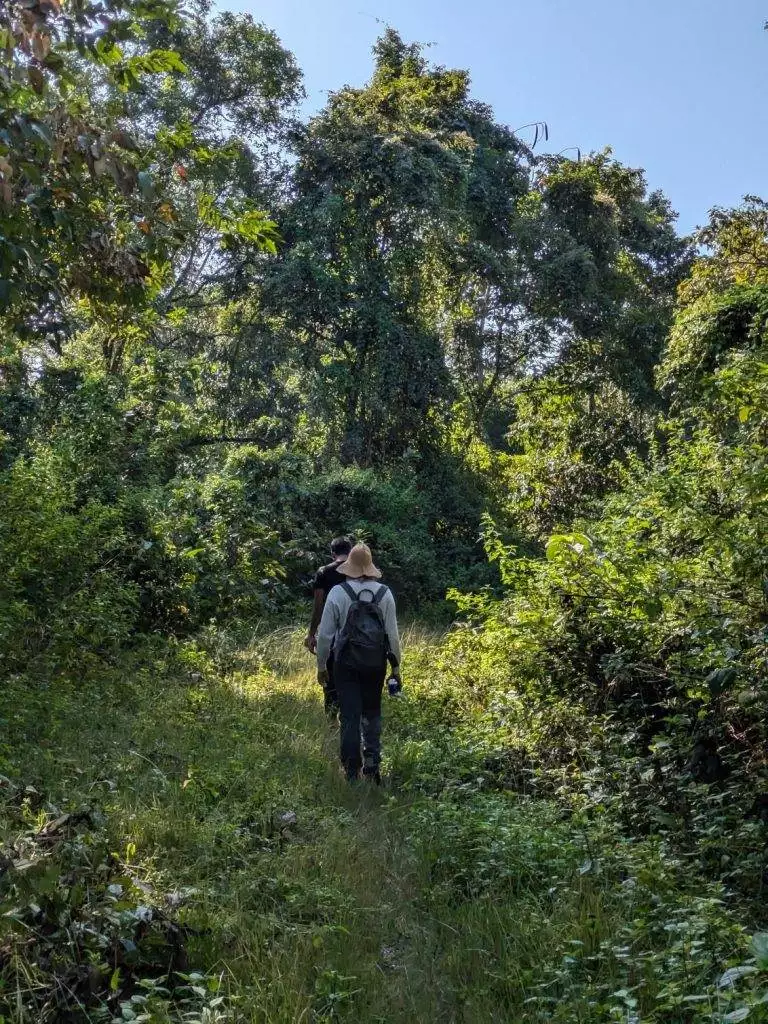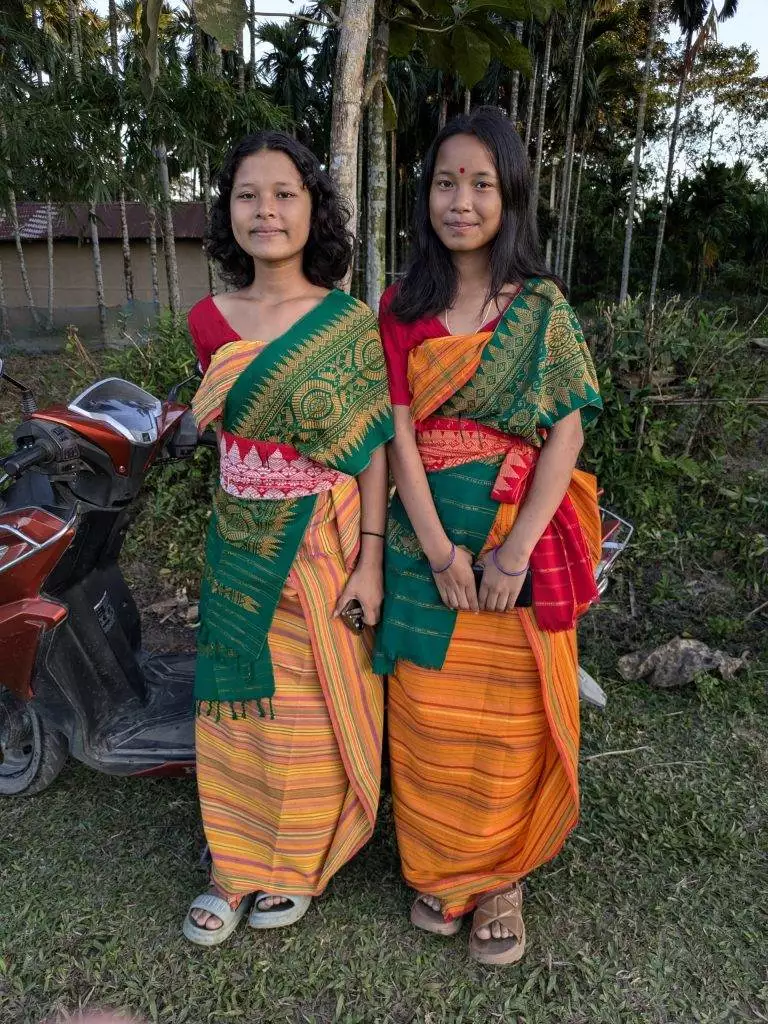As I watched thousands of Amur Falcons swoop across the dawn sky on my final morning in Assam, I couldn’t help but reflect on how the most meaningful journeys often come in small packages. I’m Gwen, originally from the UK but now calling Goa home, and as the social media marketing manager for Curtain Call Adventures, I’ve had the privilege of experiencing some of Northeast India’s most captivating destinations. This recent three-day retreat in Assam marked my fifth adventure with Julie, following memorable expeditions through Sikkim, Manipur, and Meghalaya.


Why This Retreat?
After several fast-paced tours across the Northeast, the promise of a short but sweet retreat based at a single location held immediate appeal. The centre piece of this journey was the Dwisa Grongani, a cultural festival I’d become familiar with through my social media work. As only the second edition of this emerging celebration of Garo culture, it offered a unique opportunity to experience these traditions without venturing into Meghalaya’s remote Garo Hills. The prospect of meeting Erica, the festival’s passionate founder, added another layer of intrigue to the journey.
The Journey Begins: Into the Heart of Assam
Our adventure began at Guwahati airport, where our small group of seven gathered from various corners of India – Mumbai, Bangalore, Chennai, and myself from Goa. The drive to Wild Mahseer, our home for the next three nights, was a journey in itself. Breaking up the five-hour drive, we visited a government-run craft centre showcasing the region’s expertise in bamboo, cane, and water hyacinth weaving – a perfect introduction to Assam’s rich artisanal heritage. Assam’s days are shorter than those we are used to on “mainland” India – and the sun set around 4:45pm. We just managed to cross the Brahmaputra as the sun was dipping below the horizon.
Arriving at Wild Mahseer after sunset created an air of mystery that made the next morning’s reveal all the more magical. This heritage property, once a British tea planter’s bungalow, has been lovingly restored to its former glory while embracing sustainable tourism principles. Set within a 150-year-old tea estate, Wild Mahseer takes its name from the mighty game fish found in the nearby river. The property’s colonial-era buildings, surrounded by manicured gardens and ancient trees, offer a glimpse into Assam’s tea-growing heritage while providing all the comforts of a boutique hotel.


Into the Wild: Nameri National Park
Our first full day began with an early start towards Nameri National Park, a pristine 200-square-kilometer wilderness that stands as one of Assam’s lesser-known treasures. Unlike many of India’s national parks, Nameri offers a unique proposition – it can only be explored on foot, making the experience more intimate and immersive. After crossing the Jia Bhoroli River by canoe, we found ourselves in a forest that felt delightfully untouched by time.
Our guide, Sushil, proved to be a walking encyclopedia of local birdlife. As we traversed the park’s trails, his keen eye and expertise helped us spot numerous species in the canopy above. The beauty of Nameri lies not just in its biodiversity but in its solitude – we encountered only a handful of other visitors during our three-hour trek, making it feel like our own private wilderness.


The Dwisa Grongani Festival: A Cultural Awakening
By early afternoon, we found ourselves in the village of Uttar Rongagora Garogaon, where the second edition of the Dwisa Grongani festival awaited. There’s something special about being part of a festival in its infancy, watching a cultural celebration take root and grow. Julie had the honour of inaugurating the festival, cutting the ribbon that would welcome visitors to this celebration of Garo culture. We were welcomed with a traditional Garo dance, performed by the younf men and women of the village, all dressed u] in their traditional Garo ware. The festival grounds, set against a backdrop of stunning rice fields – some emerald green, others turning golden in the autumn sun – created a picture-perfect setting. Erica, the festival’s founder, welcomed us with traditional Garo hospitality, including the infamous rice beer. This potent brew, definitely not for the faint-hearted, offered a genuine taste of local tradition. As I wandered through the rice fields, camera in hand, I even made friends with a playful baby goat – one of those unplanned moments that often become cherished memories.

A Day of Simple Pleasures
Our third day began with an early morning exploration of Wild Mahseer’s Botanic Ark, a living museum of local flora. The property’s collection of bamboo species was particularly impressive, with some stalks reaching heights that seemed to touch the sky. This botanical sanctuary serves as both a conservation project and an educational resource, highlighting the region’s incredible biodiversity. Did you know that certain types of bamboo can grow 36 inches within a 24-hour period, at a rate of almost 1.5 inches an hour? Incredible.
The highlight of the day was undoubtedly our river float on the Jia Bhoroli. As we drifted along the crystal-clear waters, sparkling with mica, the snow-capped Himalayas provided a majestic backdrop. The experience was meditation in motion – feet dangling in the cool water, surrounded by nothing but the sounds of nature. Our peaceful drift was punctuated by wildlife sightings, including a lone male elephant along the riverbank and various bird species soaring overhead.’


Meeting “Tarzan Nani”: A Lesson in Sustainable Living
Perhaps the most profound encounter of our journey was meeting “Tarzan Nani,” an elderly Garo woman who embodies the true spirit of sustainable living. Seventeen years ago, she made the remarkable decision to leave her village and establish a solitary life in the forest. Her traditional Garo wooden house, cleverly designed with the kitchen downstairs and living quarters above to avoid floods and elephants, stands as a testament to indigenous wisdom.
What struck me most was her philosophical approach to sharing her space with wildlife. When she told us about “Elder Brother” (her endearing term for elephants) destroying her potato crop, there wasn’t a hint of bitterness in her voice – just acceptance and respect for her wild neighbours. In an age where sustainability has become a buzzword, Tarzan Nani quietly demonstrates what it truly means to live in harmony with nature. We asked her age, but she, like many of ger generation didn’t know. Birth certificates not being common in much of tribal India when she was born. We figured she might have been in her 60s though. I asked her if she ever gets lonely living her life in isolation. She responded that her sister (who was with her when we visited) often visits, and vice versa, and she visits the village when she needs to buy rice and oil. So I guess the answer was no!


We dropped by the Dwisa Grongani grounds again, and the light was perfect, capturing local girls performing in the sinking sun was very special. We were told the festival really kicks off at night when the entire village parties, and surrounding villagers also join in. One day I’ll return and experience this myself. As it was we had to return to the hotel, for our final dinner. We also celebrated Aatma’s birthday, who was travelling solo to enjoy her 60th birthday with a difference.
A Spectacular Finale
My final morning began before sunrise, thanks to Sushil’s promise of an extraordinary sight. The promise was well kept – we witnessed thousands of Amur Falcons roosting in a nearby village, taking a brief respite on their incredible journey to South Africa. While Nagaland might be more famous for these magnificent birds, our experience felt no less special. The sight of these graceful creatures against the backdrop of misty paddy fields and snow-capped Himalayas created a perfect farewell scene.


This three-day retreat exemplified what Curtain Call Adventures does best – supporting local initiatives while offering authentic experiences that go beyond typical tourist trails. The Dwisa Grongani festival, though in its infancy, represents the kind of grassroots cultural preservation that deserves recognition and support. Erica’s vision and determination in organizing this festival single-handedly speaks to the entrepreneurial spirit that’s alive and well in Northeast India.


As I reflect on this journey, it’s clear that the magic of travel often lies in these shorter, more focused experiences. In just three days, we witnessed remarkable wildlife, experienced genuine cultural exchanges, and met individuals who challenged our perspectives on modern living. The combination of Wild Mahseer’s colonial charm, Nameri’s pristine wilderness, and the warmth of local communities created an experience that felt both grounding and inspiring.
For those seeking to explore Northeast India’s lesser-known corners, this pocket of Assam offers a perfect blend of wildlife, culture, and comfort. It’s a reminder that sometimes the most meaningful journeys aren’t about covering vast distances, but about diving deep into the heart of a place and its people.


